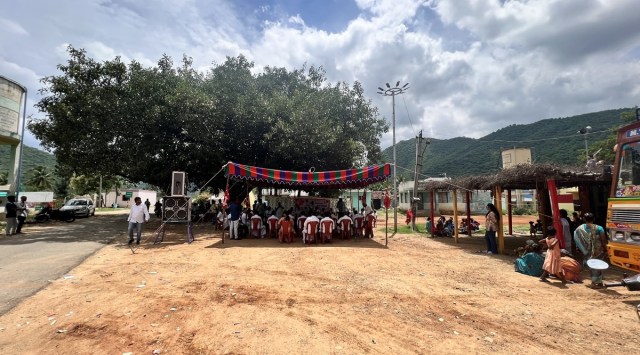31 yrs later, Tamil Nadu village gathers to recall day of horror, find closure after HC verdict
On Friday, the Madras High Court dismissed all appeals and upheld a sessions court order that found 215 people, mostly from the police and forest departments, guilty of the atrocities, including rape of 18 women, during a raid in Vachathi.
 Vachathi residents at the banyan tree near which the village’s women were rounded up on June 20, 1992. (Express photo by Arun Janardhanan)
Vachathi residents at the banyan tree near which the village’s women were rounded up on June 20, 1992. (Express photo by Arun Janardhanan) THE WOUNDS on their bodies may have healed but memories of their ordeal on June 20, 1992, when a large contingent of police, forest and revenue officials swooped on their village and unleashed terror — raping their women and destroying their homes — are still fresh.
On Friday, the Madras High Court dismissed all appeals and upheld a sessions court order that found 215 people, mostly from the police and forest departments, guilty of the atrocities, including rape of 18 women, during a raid in Vachathi, a tribal village located in a forest area of Dharmapuri district, around 300 km from Chennai.
A day after the verdict, the village gathered under a generations-old banyan tree, a silent witness to the atrocities and the struggle that followed, to recount their emotional journey, and to mark a sense of closure although it took more than 31 years to come.
According to the villagers, the raiding party entered the village under the pretext of a crackdown on sandalwood smuggling.
“Around 11 am on June 20, 1992, they entered our village, damaging homes and contaminating our water. By 5 pm, they gathered about 200 women under the banyan tree, and handpicked 18 of us and led us to the nearby lake, under the pretext of retrieving hidden sandalwood logs,” one of the rape survivors told The Indian Express, standing under the same tree.
“They stopped the women officers who volunteered to come with us. The abuse lasted till around 9 pm near the lake. Subsequently, we were taken to Salem Central Prison, where we spent three months,” she said, her voice trembling with years of stifled pain.
Although it took years, the High Court’s verdict has come as a ray of hope for some of them.
“With this verdict, there’s a new-found purpose in our lives. Perhaps, we fought this battle for our future generations, to uphold their dignity,” said another rape survivor.
In his order, Justice P Velmurugan also directed the Tamil Nadu government to immediately release Rs 10 lakh compensation to each of the rape survivors as ordered by a division bench in 2016, and recover 50% of the amount from the convicts.
The long journey to justice, to see the perpetrators being held accountable, however, has had its effect.
One of the survivors said: “What is justice? That idea probably helped us fight the case. But is that really a true word, truly authentic?”
“Of the 18, 15 of us were not married, in our tender age of 16 or 17… we faced severe societal prejudice. The village got a stigma. Eventually, we got married to close relatives,” she said.
She also spoke about the delayed medical examinations, which were conducted “two years later, when the CBI started the investigation”.
One of the youngest among the survivors, a mother of two now, said sleepless nights of fear and anxiety followed the incident. “Those sleepless nights I recall now, not the physical pain or severe bleeding or wounds we suffered.”
At the gathering under the banyan tree on Saturday, P Shanmugam, who led the villagers’ cause, gave an address. Barely two minutes later, his voice cracked, overwhelmed by the haunting memories of the devastation he witnessed when he first entered the village after the raid.
Now a central committee member of the CPI(M), Shanmugam broke down intermittently as he recalled each harrowing detail, faces, and names of women who were pregnant at the time, and children who were in prison along with their abused mothers for weeks and months.
The emotional weight of the moment hung heavy in the air as the villagers and Shanmugam collectively remembered the long and arduous journey they weathered together.
The first piece of information Shanmugam received about the Vachathi raid was on July 7, 1992 – more than a fortnight after the incident – at a tribal association’s conference held in the nearby Sitheri Hills. Some youths from the village who had escaped police action informed the gathering about it.
As Shanmugam tried to gather more information, he filed a petition and organised a protest in front of the Harur taluk office on July 13. He and six other leaders visited the ravaged village the next day.
At a time when sandalwood smuggling was rampant in the region, what probably triggered the uniformed personnel to attack the village was an incident that morning on June 20, Shanmugam told The Indian Express.
He said a team of forest officers had visited the village to investigate sandalwood smuggling. An elderly hearing-impaired man, Perumal, was asked about the lake but he was slow in answering, following which an officer slapped him. This triggered anger and the villagers attacked the team of forest officers, who were mostly in plain clothes. Later, village elders gave the team first aid and sent them to the hospital in Harur.
But within hours, the retaliation came. A large police and forest force was mobilised from nearby districts, and they wreaked havoc in the village.
“After we reached the village on July 14, we encountered a chilling scene of destruction and silence. Almost all houses were damaged, and no one was speaking. Everything was destroyed or stolen. It was a silenced village,” Shanmugam recalled.
“It took three hours for us to go around the village and bring some 45 people under the banyan tree to make them speak. We found some villagers hiding in the bushes as they were all panicking. Only three women told me about the sexual abuse,” he said. The accounts of the other women surfaced only later as they were then in prison.
“The damage was extensive with contaminated wells, destroyed food grains, stolen livestock, and vandalised homes,” Shanmugam said.
The husband of a rape survivor said the police remained in the village for three days, and slaughtered most of their livestock – cattle and goats. “Their remains were discarded in the wells. They also contaminated the wells by pouring oil from our pump sets which they stole,” he said, recalling that all food items were destroyed.
As they left, the raiding party took the remaining cattle and goats to the Harur town market and sold them, he said.
After Shanmugam took the case to Chennai, and his party raised it in the Assembly, the then Chief Minister J Jayalalithaa denied it, calling it an attempt to defame her government. The government also labeled the villagers as sandalwood smugglers.
The first breakthrough was a report by B Bhamathi of the then state SC/ST Commission. Her findings led the High Court to order a CBI probe.







